
9 Best Postmark Alternatives Compared (2025)
Postmark has been a popular solution among businesses looking to send transactional email messages efficiently and reliably. However, recent changes to Postmark’s pricing model and added restrictions on servers and domains have made it a less cost-effective choice for growing teams or businesses sending large volumes of emails.
If you’re looking for more affordable Postmark alternatives, without compromising features or reliability, this blog post is for you.
Disclaimer: The information below is accurate as of July 2025.
Ditch extra costs with code MAKETHEMOOVE
Get 25% off for 3 months and enjoy advanced features.
Switch to MoosendWhy You Should Consider a Postmark Competitor
There are various reasons leading users to switch from Postmark or start considering other alternative options. Here are the most notable ones according to user reviews:
- Steep pricing: Postmark is on the expensive side of the pricing spectrum, thus being less favorable for businesses delivering large email volumes.
- Restrictions on the number of servers and domains: Previously, there were no such restrictions. Now, users needing more than six servers and ten domains have to purchase a more expensive plan.
- Short-term data retention: Unlike other Postmark alternatives, the tool has a rather short retention timeframe (45 days), which can be a downside for some users.
- Limited marketing capabilities: While Postmark provides basic bulk email sending functionality (Streams feature), it lacks advanced automation and segmentation options. This is not the case with all-in-one solutions.
Now, let’s explore the top alternatives to Postmark.
Top Postmark Alternatives: Comparison Table
Here’s a quick comparison table with the top Postmark alternative solutions.
| Free Plan/Trial | Pricing | Best Feature | |
| Postmark | Yes | $15/month | Automatic IP warm-up |
| Moosend | Yes (30-day free trial) | $9/month | Easy-to-implement automation |
| SendGrid | Yes (60-day free trial) | $19.95/month | Industry-leading deliverability rates |
| Mailgun | Yes | $15/month | Built-in email address validation |
| Amazon SES | Yes | $0.10 per 1,000 emails sent | Extremely low pricing (especially within AWS) |
| Brevo | Yes | $9/month | SMS & WhatsApp campaigns |
| Mailjet | Yes | $17/month | Real-time email collaboration |
| SparkPost | Yes | $20/month | Powerful analytics |
| Mailchimp | Yes | $20/block | Pre-built customer journeys (automations) |
| Mailtrap | Yes | $15/month | High inboxing rates and fast delivery |
1. Moosend
Pricing: Starts at $9/month, 30-day free trial (Sign up here)
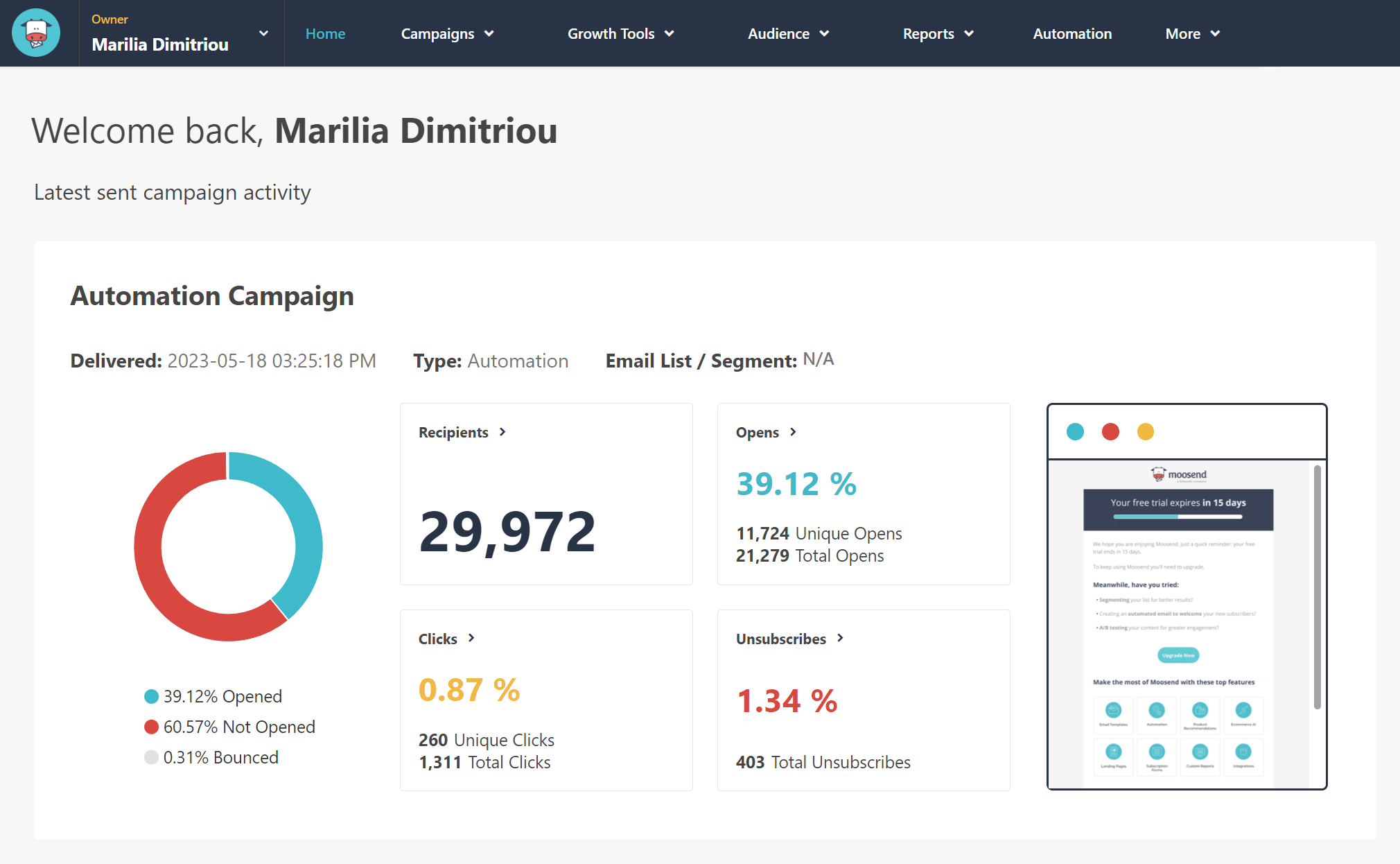
Moosend is a top Postmark alternative if you’re looking for an affordable service. With it, you can deliver key transactional emails, such as password reset emails, order and shipping confirmations, as well as receipts. Unlike Postmark, it supports both transactional and marketing messages all in one place.
Moosend makes it easy to send transactional emails through its reliable and well-documented API. You can choose to send messages using a ready-made template, custom HTML, or even a web link. The platform also supports personalization, so each email feels more relevant to the customer. Plus, Moosend’s drag-and-drop editor and clean interface make it simple for anyone to create and manage email templates.
Regarding marketing emails, you can design and send them using the same platform (no need to switch to a different tool). You get easy-to-implement marketing automation, a plethora of triggers and actions, and A/B testing options. To track your performance, Moosend provides rich, real-time analytics, giving marketers useful insights.
Moosend Features
- Unlimited emails
- Fully customizable transactional email templates
- Dynamic templating to save time
- Excellent email deliverability rates
- Subscription forms and landing pages
- Integrations with eCommerce platforms, CRM, CMS, and more
- Responsive customer support (replies within a few minutes)
Pros
- Flexible and well-documented transactional API
- Affordable pricing, especially for higher email volumes
- Email automation for abandoned carts, welcome flows, or post-purchase follow-ups
Cons
- Not as granular event logging
- Signup forms could be more customizable
Pricing
Moosend offers a 30-day free trial, letting you access core features (including the SMTP server) and deliver unlimited emails. Paid plans start at $9/month, and transactional emails can be purchased as an add-on to your Moosend+ plan.
2. SendGrid
Pricing: Starts at $19.95/month, 60-day trial
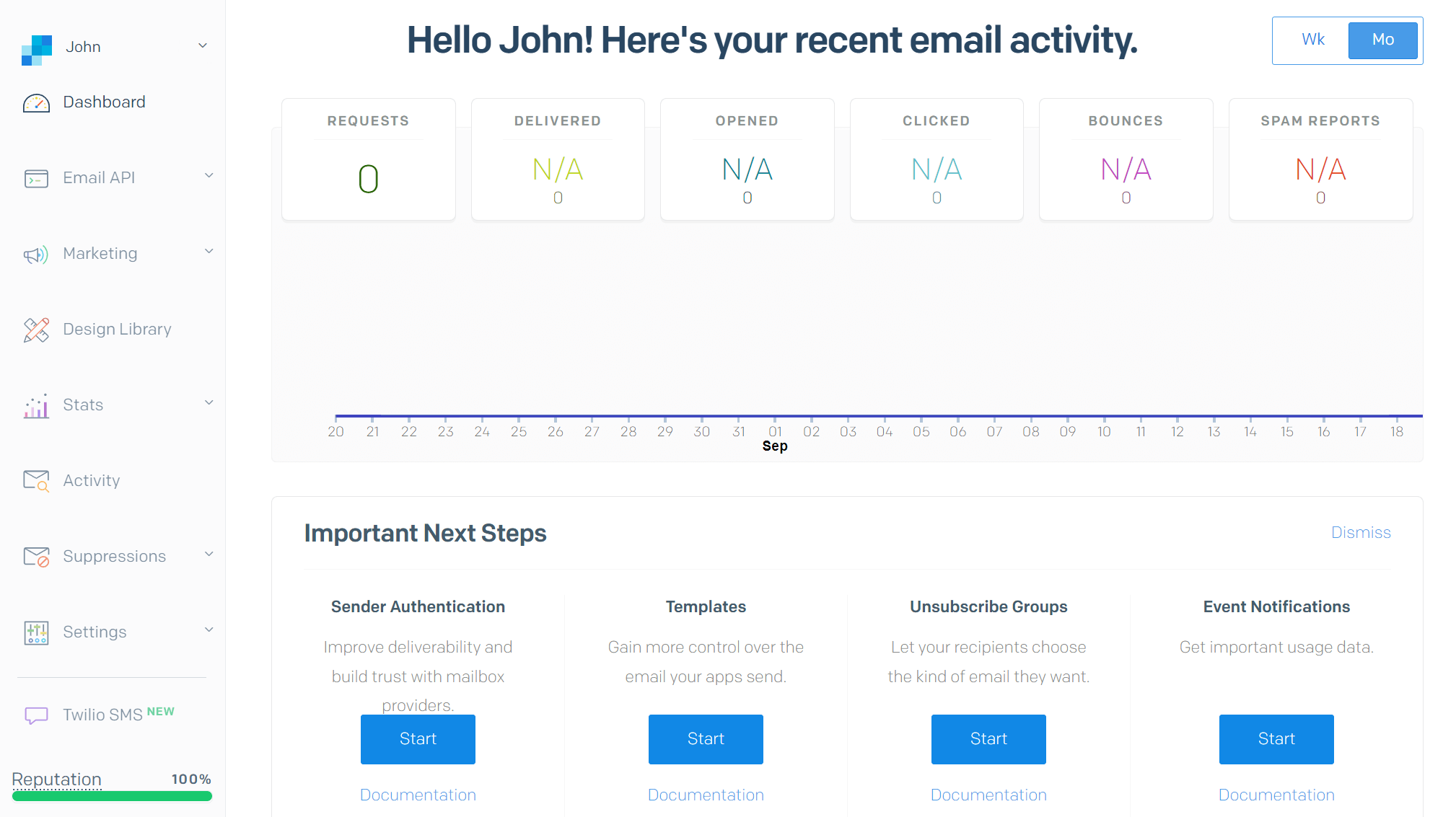
Twilio SendGrid is a cloud-based email delivery service that lets you deliver transactional and marketing emails at scale without sacrificing email deliverability. This Postmark alternative is a great choice if you’re looking for features such as domain authentication, dedicated IP addresses, and reputation monitoring.
With its strong infrastructure and email testing tools, SendGrid helps ensure your transactional messages reach inboxes quickly and securely. The email builder is user-friendly, and you can create and customize responsive emails with ease using dynamic email templates.
To ensure your deliverability remains high, the platform offers delivery optimization tools, such as SPF records, custom DKIM, and suppression management.
For troubleshooting, SendGrid has a great knowledge base and detailed documentation. However, some users have pointed out gaps, making it harder to resolve certain issues without contacting support.
SendGrid Features
- All-in-one solution for marketing and transactional emails
- APIs, SMTP relay, and webhooks
- Comprehensive email management
- Dynamic email templates
- Email validation
Pros
- Supports high-volume sending with advanced scalability options
- Industry-leading email deliverability rates
Cons
- Not ideal if you want powerful automation
- The interface can feel a bit complex for beginners
Pricing
SendGrid offers a 60-day free trial period, during which you can send 100 emails/day and store up to 100 contacts. After that, the Email API paid pricing starts at $19.95/month for up to 50,000 emails per month.
3. Mailgun
Pricing: Starts at $15/month, free plan
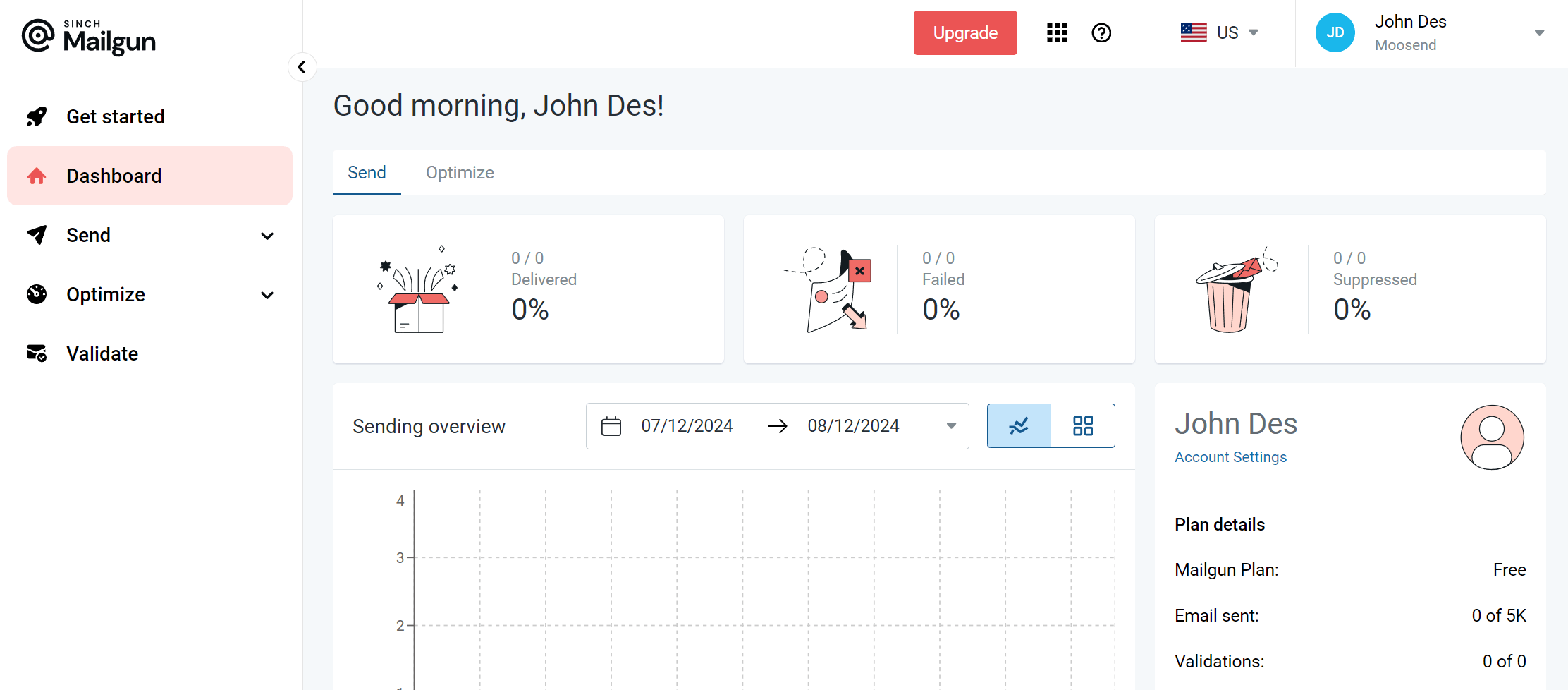
Mailgun is a solid Postmark alternative if you want a developer-centric platform focused on transactional emails at scale. It excels at sending password reset emails, order receipts, and account alerts, while giving you advanced control over your sending infrastructure. You can personalize transactional messages through dynamic templates and take advantage of Mailgun’s detailed event tracking to monitor every step of the delivery process.
Another advantage is its robust SMTP relay and API, giving developers granular control and advanced configuration options. Its infrastructure lets you send large volumes of email with impressive speed and reliability, making it a great fit for SaaS applications or any project where transactional messaging is mission-critical.
Although Mailgun is more technical in nature and lacks built-in marketing email tools, it integrates easily with third-party solutions if you need promotional campaigns. You’ll also get features like email validations, inbox placement tests, and advanced routing to optimize your sending.
Another major benefit is Mailgun’s 24/7 support, which is responsive and helpful. Finally, the platform’s scalable pricing allows you to pay for what you actually send, giving you flexibility as you grow.
Mailgun Features
- Comprehensive API documentation
- Inbox placement testing
- Send time optimization
- Suppression management
- Responsive 24/7 support
Pros
- Powerful, developer-first transactional API
- Great email deliverability due to its infrastructure
Cons
- No built-in marketing campaign builder
- The interface is less beginner-friendly
Pricing
This Postmark alternative has a free plan, letting you send 100 emails per day. Paid plans start at $15/month for 10,000 emails/month and 1 day of log retention.
4. Amazon SES
Pricing: $0.10 per 1,000 emails sent, free plan
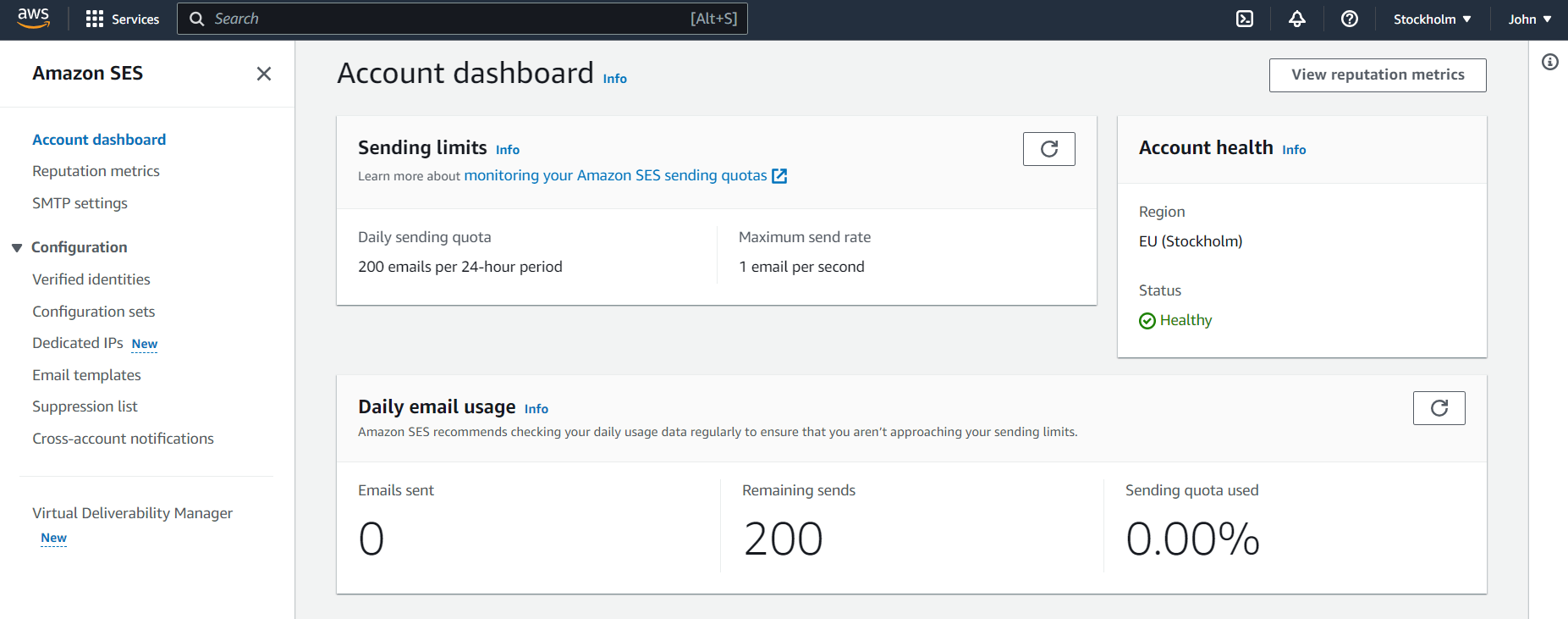
Amazon SES is another option worth considering, especially for businesses already using AWS. This affordable Postmark alternative is designed for high-volume transactional emails, with the ability to handle millions of messages reliably.
The platform provides a flexible SMTP relay and API, allowing developers to integrate email sending directly into their applications with precise configuration options. Deliverability is strong due to AWS’s infrastructure and optional dedicated IPs. The platform also supports authentication features like DKIM and SPF for improved trust.
Another pro is its competitive pricing, which can drastically reduce costs compared to Postmark, especially if you are already operating on AWS. For many organizations, Amazon SES offers scalability and stability for transactional communications.
While Amazon SES is highly powerful, its developer-oriented setup can be challenging for beginners. There’s no built-in drag-and-drop builder or marketing campaign support, so businesses needing those features may need to connect to an external marketing tool.
Amazon SES Features
- Flexible SMTP interface
- Powerful email-sending API
- Deliverability dashboards and reputation monitoring
- Support for dedicated IP addresses
- Automatic bounce and complaint handling
Pros
- Affordable pricing, especially for high volumes
- Highly scalable with AWS-grade infrastructure
Cons
- Steep learning curve for non-developers
- No built-in marketing campaign tools
Pricing
Amazon SES charges $0.10 per 1,000 emails sent, with up to 62,000 emails free each month if you send from an Amazon EC2 server. Dedicated IPs cost an additional $24.95/month per IP, and data transfer fees may apply depending on your region.
5. Brevo
Pricing: Starts at $9/month, free plan
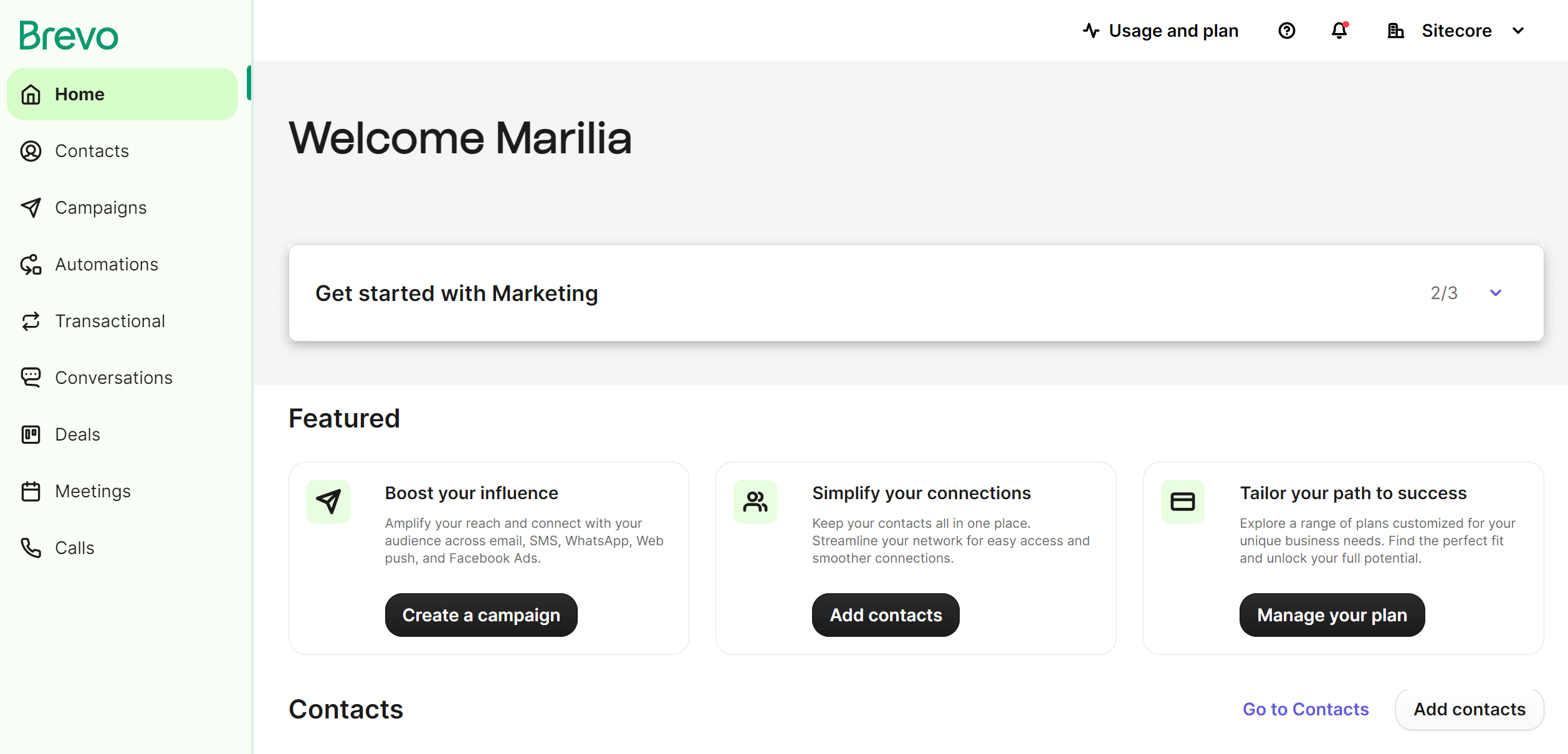
Brevo is a versatile multi-channel marketing platform that equips businesses with tools to deliver promotional and transactional messages. This Postmark alternative offers a drag-and-drop campaign builder and a visual workflow editor to automate your customer journeys. With its advanced templating feature, you can build dynamic campaigns without much effort.
Brevo lets you send transactional campaigns without needing a separate plan. Even on the free plan, you can send 300 emails per day, regardless of their type.
Other useful features of the platform include customizable signup forms and landing pages. You can also target your audience with SMS and WhatsApp campaigns. Finally, Brevo includes a handy Sales CRM that lets you store crucial information about your customers and open deals.
Brevo Features
- RESTful APIs, SMTP, and webhooks
- Unlimited log retention
- SMS marketing and WhatsApp campaigns
- Real-time email statistics
- Integration with major CMS platforms and other third-party apps
Pros
- Flexible platform with affordable pricing
- Easy-to-use automation workflows for transactional triggers
Cons
- Deliverability may require tuning for high-volume transactional emails
- Fewer advanced developer-focused debugging tools compared to Postmark
Pricing
Brevo’s free plan allows you to send 300 emails/day. To access more features and increase limits, paid plans start at $9/month for 500 contacts and 5,000 emails/month.
6. Mailjet
Pricing: Starts at $17/month, free plan
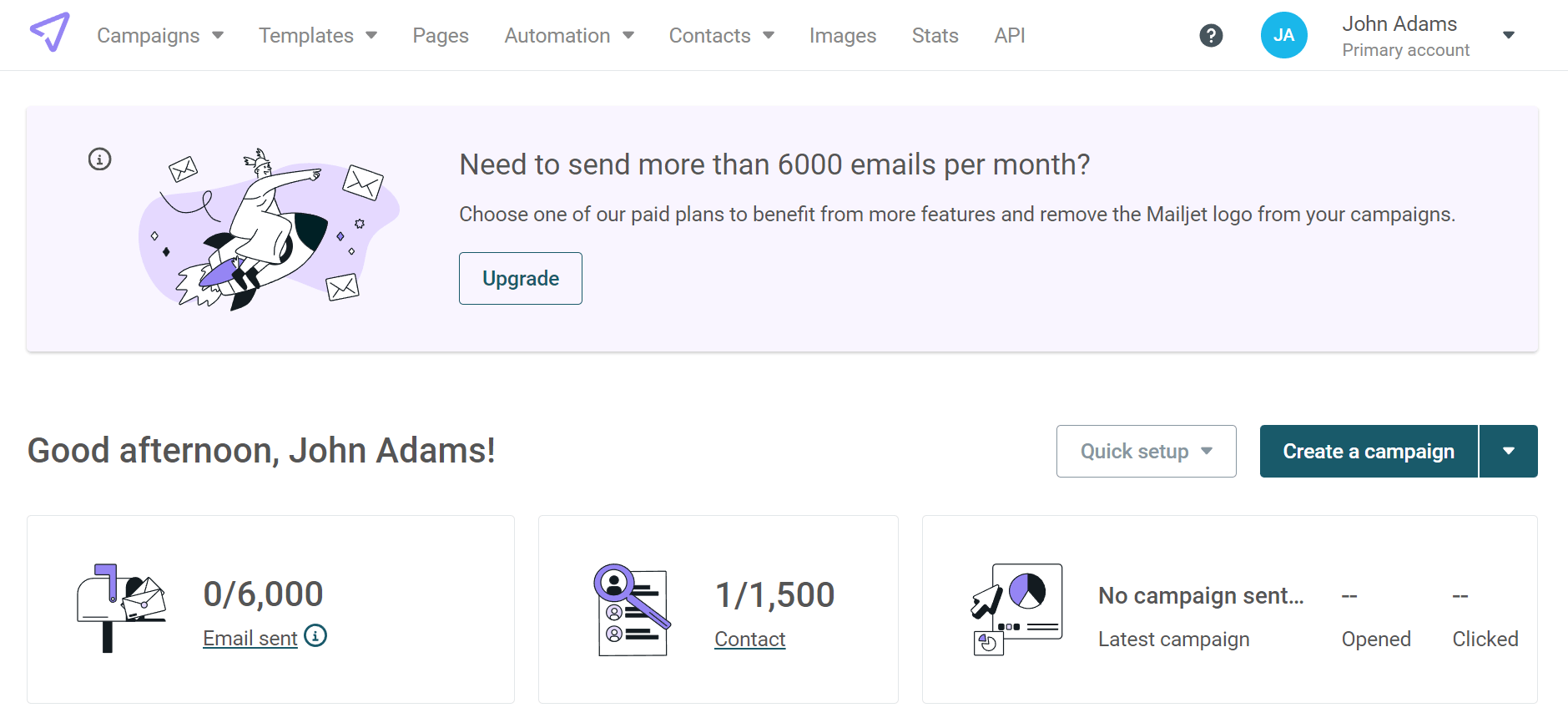
Mailjet by Sinch is an easy-to-use email service that lets you handle both marketing and transactional emails in one place, without switching platforms. For transactional messages, you can deliver communication like order confirmations, password resets, or shipping updates straight from your app using Mailjet’s API or SMTP relay.
It’s built to make that process smooth, and you can even manage dynamic content and templates to keep messages feeling personal and on-brand.
Mailjet also helps you collaborate on building email templates, thanks to features like shared workspaces and approval flows. The platform’s reporting and analytics keep you in the loop on opens, clicks, and delivery, giving you enough insight to stay confident that your transactional messages hit the mark.
Overall, Mailjet strikes a nice balance between ease of use and flexibility. As such, it’s a solid option if you want reliable, scalable transactional capabilities without giving up the ability to run marketing campaigns.
Mailjet Features
- SMTP relay and transactional API
- Collaboration and approval workflows
- A/B testing tools
- GDPR compliance tools
- Advanced deliverability monitoring
Pros
- Team collaboration tools for building and approving templates
- Simple, user-friendly interface
Cons
- Automation is locked behind expensive plans
- Event tracking isn’t as deep as Postmark’s
Pricing
This Postmark alternative offers a free plan allowing up to 6,000 emails per month (200 per day). Mailjet’s paid pricing then starts at $17/month for 15,000 emails, removing daily limits and including more advanced features.
7. SparkPost
Pricing: Starts at $20/month, free plan
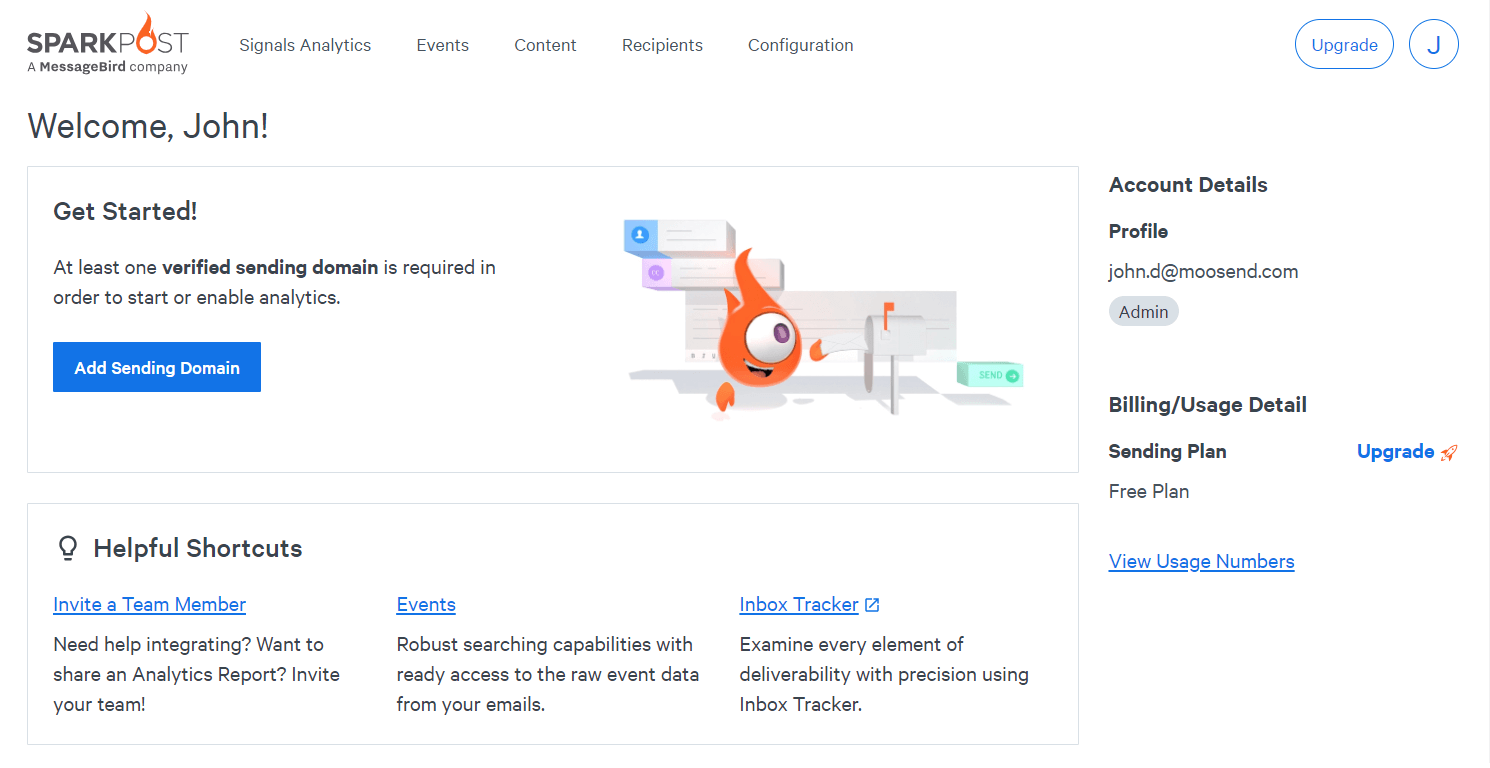
SparkPost by MessageBird is a well-known provider for delivering transactional emails. You can use it to send time-sensitive messages like receipts, account alerts, or password resets with speed and consistency. The platform offers both an SMTP relay and a robust API to plug into your app, giving you flexible options depending on how you like to integrate.
What sets Sparkpost apart is its advanced deliverability technology, including predictive analytics that help you spot issues before they impact your inbox placement. Plus, you get event-level tracking, making it easy to see exactly what happened to every message in the pipeline.
While Sparkpost is focused on transactional email, it can support basic marketing emails as well. However, you may want a separate tool for more advanced campaign creation. Overall, if you need high-volume transactional email with best-in-class deliverability and data, Sparkpost is a smart alternative to Postmark.
Sparkpost Features
- Dynamic email templates
- Compliance and enterprise support
- Real-time alerts
- Reputation monitoring dashboards
- Detailed event-level tracking
Pros
- Strong email deliverability
- Powerful analytics and predictive deliverability tools
Cons
- Higher starting price compared to some competitors
- Learning curve for new users
Pricing
The platform has a free plan ideal for testing, allowing 500 emails/month. SparkPost’s paid plans start at $20/month, giving you 50,000 emails per month.
8. Mailchimp
Pricing: Starts at $20/month, free plan
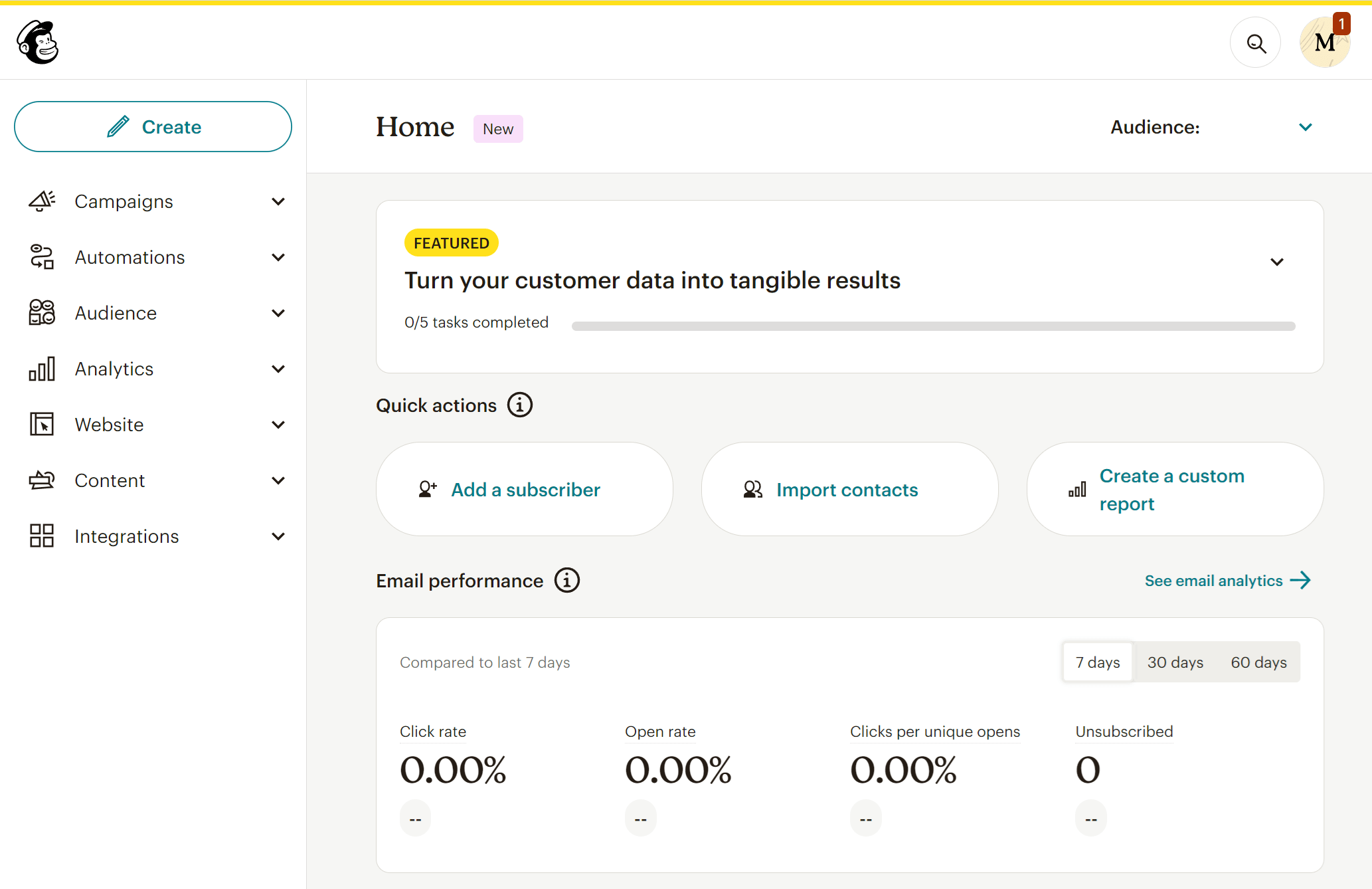
Mailchimp is a household name in email marketing, but it can also handle your transactional emails through its Mandrill extension. That means you can manage order confirmations, password resets, and shipping notifications alongside your newsletters and promotional campaigns, keeping everything neatly in one ecosystem.
Mandrill’s API and SMTP relay give you flexibility to deliver transactional emails, with tracking for opens, clicks, and delivery status. Meanwhile, Mailchimp’s robust marketing suite provides best-in-class design tools, easy-to-build automations, powerful segmentation, and customer journey mapping.
If you have a team that likes having marketing and transactional messages under one roof, Mailchimp can be a convenient solution. Just keep in mind that you need a separate paid plan for marketing emails. Also, data retention is limited to 30 days (compared to Postmark’s 45-day period).
Mailchimp Features
- Drag-and-drop email designer
- Marketing automation workflows
- Customer journey builder
- Behavior-based triggers
- Dedicated IPs
Pros
- Great template builder with rich design options
- Extensive automation and customer journey features
Cons
- Separate paid plans for transactional and marketing emails
- It can get expensive the more your list grows
Pricing
Mailchimp offers a demo plan that allows new users to send up to 500 free emails to any email address on their verified domain. Regarding paid options (for transactional emails), you can purchase blocks starting from $20/block, giving you 25,000 emails/block.
9. Mailtrap
Pricing: Starts at $15/month, free plan
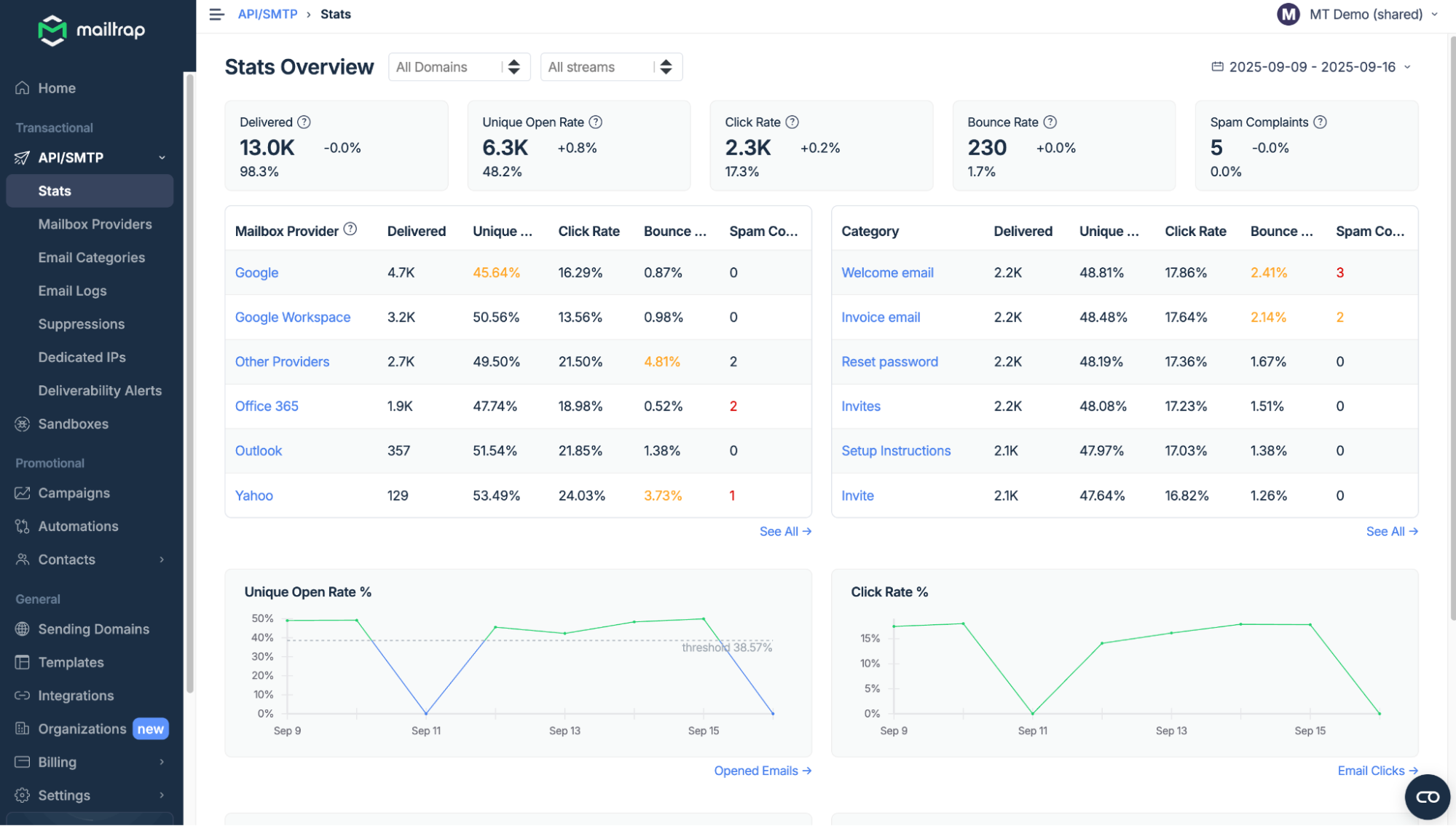
Mailtrap is an email delivery platform for developer and product teams to send emails and maintain a healthy infrastructure. As a direct Postmark alternative, it offers a robust Email API and SMTP service with high inboxing rates and fast email delivery. And like Postmark, Mailtrap has separate sending streams for transactional and bulk emails.
What sets Mailtrap apart is its “helicopter view” analytics, providing deep, actionable insights into deliverability performance. This way, teams can quickly identify and fix any sending issues.
Mailtrap also offers a drag-and-drop email builder (and an HTML editor) with AI assistance and access to a free stock library. Plus, the platform has detailed documentation including a knowledge base, well-documented APIs and SDKs, and even YouTube tutorials.
Mailtrap Features
- High-speed email delivery
- Flexible and developer-centric Email API and SMTP Service
- Detailed analytics
- 24/7 expert technical support
Pros
- Strong focus on deliverability and performance analytics
- Great for transactional emails
- Responsive customer support
Cons
- Lacks advanced, multi-step marketing automation features
- Technically oriented, making it a better fit for users with development knowledge
Pricing
Mailtrap offers a free plan that includes 3,500 emails per month (150/day). Paid plans start at $15 for 10,000 emails on the Basic plan, with Business and Enterprise tiers available for higher volumes and advanced features like dedicated IPs.
How We Selected The Tools
All of the tools in this list have been tested by our team to provide an unbiased description of its features and capabilities.
We spent hours setting up new accounts and trying each software to provide an accurate experience and show users exactly what they will come across when they sign up. Find more information about our software selection methodology on how we choose tools to feature on the Moosend Blog.
Additional Resources
If you’re looking for resources to make an informed decision, check out the following posts:
Selecting The Best Postmark Alternative
To choose the right Postmark alternative, start by clearly defining what you need most. Consider your available budget, the level of support you require, and whether or not you need any other marketing tools included.
Some services come with great deliverability out of the box, while others offer more control and customization if you’re comfortable managing technical details.
Don’t forget to take advantage of free trials, explore documentation, and don’t hesitate to test deliverability before committing. This way, you’ll be confident you’re making the smartest choice for your business.
Frequently Asked Questions
Here are some of the most common questions around Postmark alternatives.
1. What is the best alternative to Postmark for transactional emails?
The best Postmark alternative depends on your specific needs. If you’re looking for a robust email marketing platform with powerful APIs for your marketing and transactional campaigns, consider tools like Moosend, Brevo, and Mailjet. For a more developer-oriented approach and more configuration options, you can look at Amazon SES and Mailgun.
2. How are transactional emails different from marketing emails?
Transactional emails are triggered by user actions (like order confirmations or password resets) and deliver essential, personal information. Marketing emails, such as newsletters or promotions, are mass-delivered emails to drive engagement or sales. In short, transactional emails are one-to-one messages that the user expects to receive, while marketing emails are more frequent and promotional in nature.





 Published by
Published by

 Published by
Published by